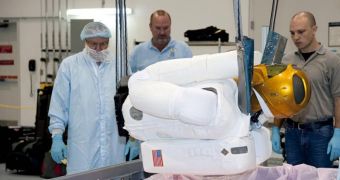Officials at the American space agency announce that they have just finished packing their advanced Robonaut 2 machine into its cargo container, and that the robotic astronaut is currently ready to fly in space.
The instrument, which is eventually destined to help astronauts carry out complex extravehicular activities (EVA), or even undertake spacewalks of their own, weighs in excess of 300 pounds (180 kilograms).
At this point, the machine is scheduled to fly into space on November 1, aboard the space shuttle Discovery during the STS-133 mission.
The instrument is currently located at the NASA Kennedy Space Center (KSC), in Cape Canaveral, Florida, where engineers are currently working out the final procedures related to transporting R2 to space.
According to officials at NASA, the humanoid robot will not enjoy the same transport privileges as its fully-human counterparts.
It will travel to the International Space Station (ISS) inside a foam-padded stowage unit, which will be placed in Discovery's cargo bay.
“Just powered down for the last time. Next time I power up will be on the ISS!” experts managing the robot wrote on the machine's own Twitter account (follow its tweets @AstroRobonaut).
“The robot is designed to work with tools that the astronauts use. It is more dexterous and more capable than its immediate predecessor, Robonaut 1,” says Robonaut project manager Ron Diftler, quoted by Space.
The robot, which has all the abilities of a human astronaut and more, was developed by experts at NASA in collaboration with colleagues at General Motors (GM).
The first Robonaut was constructed about a decade ago by experts at the NASA Johnson Space Center in Houston, who worked together with scientists from the Defense Advanced Research Project Agency (DARPA).
Now tightly fixed inside its container, the entire R2 payload weighs about 500 pounds, but makes up for only a small part of Discovery's payload, Space reports.
“The mass is what's driving the crane operations, otherwise we'd be handling the robot by hand. But the robot itself weighs on the order of 333 pounds,” says Space Station Processing Facility engineer Michael Haddock.

 14 DAY TRIAL //
14 DAY TRIAL //